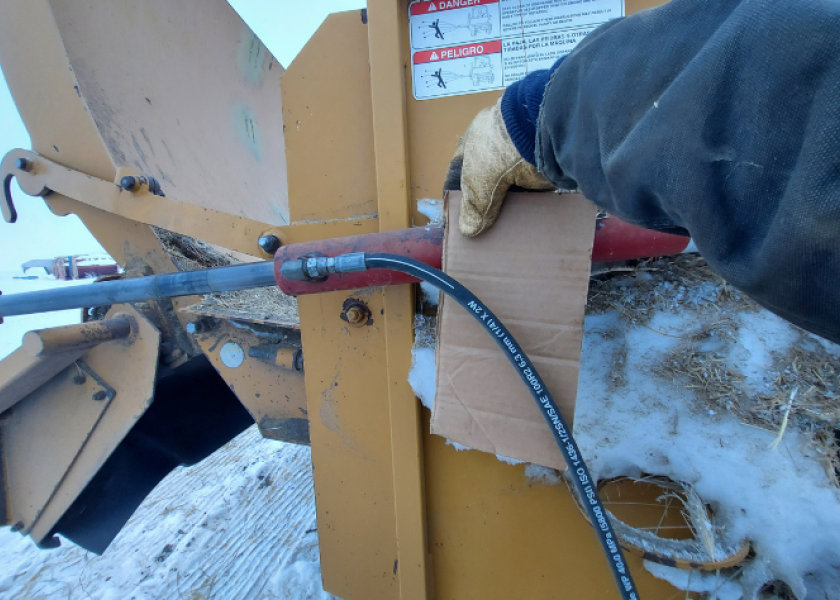Extreme cold temperatures throughout the winter months can cause challenges to hydraulic hose lines in tractors and machinery.
“The temperature of a piece of machinery can fluctuate from -20 degrees Fahrenheit to 200 degrees Fahrenheit in a matter of minutes,” says Angie Johnson, North Dakota State University Extension farm and ranch safety coordinator. “The hydraulic hoses on tractors and implements used in the winter months must be in prime condition to withstand the extreme temperature changes we face in the northern Plains.”
Hydraulic systems are critical for tractors and machines to work properly and conduct tasks year-round.
These systems store fluid under high pressure, typically 2,000 pounds of pressure per square inch (psi), up to 3,000 psi.
A hydraulic hose failure could cause extreme machine malfunction, potentially causing severe harm to the operator. Other hydraulic hose hazards include burns, skin penetration, and component failure or collapse.
Burns
Unhooking an implement or making a repair on a hydraulic system can be dangerous if the operator has not released the hydraulic pressure from the hydraulic system. This means that if the implement or loader on the tractor is in the raised position, it contains trapped hydraulic fluid that is pressurized. As pressure increases, the operating temperature of modern hydraulic systems can become high enough to cause severe burns if an operator is sprayed with escaping hydraulic oil from a puncture in the line or the immediate release of high pressurized oil from a loose hydraulic fitting.
Safety tips:
Always relieve hydraulic pressure before loosening hydraulic fittings. This includes lowering the implement (or loader) to the ground and testing your pressure relief valves to ensure they are reducing pressure buildup, if applicable on your tractor.
Move the hydraulic control lever (found inside the tractor if hooked up to an implement) back and forth several times to help relieve hydraulic pressure.
Follow instructions in the operator’s manual. Specific procedures for servicing hydraulic systems provide safety guidelines to follow when performing maintenance or repair.
Skin Penetration
Pinhole leaks in hydraulic hose lines are extremely dangerous. With the naked eye, pinhole leaks can be impossible to see. A common injury involves an operator running their hand or finger over the hose line, where the invisible pinhole leak then penetrates oil into the operator’s skin without even knowing it.
Immediately after the fluid injection, the operator may only experience a slight stinging sensation in their hand or finger and think nothing of it. After a few hours, the operator may begin to develop severe pain. If not seen by a medical provider immediately, the injury can result in a condition called gangrene, where amputation of the hand or finger is required because of the tissue damage.
Safety tips:
Shut down all equipment and release pressure before checking for hydraulic fluid leaks.
Use a piece of paper or cardboard to check for pinhole leaks in hydraulic hoses, not your hand or finger. Run the piece of paper or cardboard across the hose to identify any pinhole leaks.
Always wear safety glasses and heavy gloves when working with hydraulic systems. Note: Gloves will not prevent oil from a pinhole leak from penetrating your skin.
Seek medical attention immediately if you suspect hydraulic oil has penetrated your skin.
Component Failure or Collapse
Failure of a hydraulic hose, fitting or seal can cause a rapid release of hydraulic oil, causing the supported component to collapse. Examples of this include a loader on a tractor or a header on a combine. Gradual leaks can also cause components to drop unexpectedly, crushing a worker under the component. A combine header can weigh three tons and crush anyone who may be working underneath it.
Safety tips:
Never work under an implement, truck bed or other machine supported by a hydraulic ram/cylinder without the lock in place or other means of support. Make sure all equipment is turned off when working on it.
Even if an implement is not attached to the tractor, the hydraulic system may still be pressurized. If making repairs to the hydraulic system, never assume the implement is no longer under pressure just because it is not attached to the tractor.
Hydraulic Hose and System Maintenance
Hydraulic hose systems on tractors and machinery can fail when hoses and oil are not properly maintained. When conditions become cold, hydraulic hoses can become stiff, inelastic, brittle and lose their ability to bend. Cracks in hydraulic hoses can become more prevalent during cold temperatures, meaning visual inspection for cracks, abrasions and oily residues is crucial for equipment maintenance and operator safety.
SOURCE: By Elizabeth Cronin January 26, 2023, DROVERS
PHOTO: NDSU








